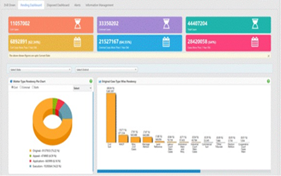What is the National Judicial Data Grid and how it could help courts.
Relevance
- GS Paper 2 Structure, organization and functioning of the Executive and the Judiciary.
- Statutory, regulatory and various quasi-judicial bodies.
- Tags: #NJDG #ecourt #supremecourt #CJI #currentaffairs #upsc.
Why in the News?
CJI D.Y. Chandrachud announces integration of Supreme Court’s data with National Judicial Data Grid portal. In a landmark move, the Supreme Court of India has officially integrated its case data into the National Judicial Data Grid (NJDG). The NJDG portal serves as a comprehensive national repository of case-related information, encompassing data on cases initiated, pending, and resolved across the entire country’s judicial system.
Chief Justice’s Emphasis on Transparency
- Describing this development as “historic,” Chief Justice of India DY Chandrachud emphasized the significance of the Supreme Court’s data onboarding onto the NJDG portal.
- He stated that this step, taken under the open data policy, is a pivotal measure towards enhancing transparency and accountability within the judicial domain.
Understanding the National Judicial Data Grid (NJDG)
- NJDG serves as a centralized database housing orders, judgments, and detailed case information from a vast network of 18,735 District and subordinate Courts as well as High Courts.
- This platform is a key component of the eCourts Project, offering real-time updates and detailed data down to the Taluka level.
Management and Administration of NJDG
- The NJDG was established as part of Phase II of the e-Courts project, a Centrally Sponsored Scheme.
- With more than 18,735 courts digitized across the nation, the data seamlessly integrates with the NJDG.
- The platform’s development is a collaborative effort between the National Informatics Centre (NIC) and the in-house software development team of the Computer Cell at the Registry of the Supreme Court. It features an interactive interface and an analytics dashboard.
Key Features of NJDG
Comprehensive Data Coverage
- The NJDG encompasses both civil and criminal cases, facilitating detailed analyses based on various parameters such as case age, state, and district.
- Its integration with Land Records data from 26 states significantly enhances its utility in tracking land dispute cases.
User-Friendly Access for Litigants
- The NJDG provides litigants with an intuitive user interface, enabling them to access case status information for an extensive database of over 23.58 crore cases and 22.56 crore orders/judgments from computerized courts.
- Beyond mere access, it offers the convenience of SMS and email alerts to keep litigants informed about the progress of their cases.
API Integration for Government Entities
- The NJDG features an Open Application Programming Interface (API), ensuring accessibility for government entities with authorized credentials.
- The commitment to expanding this access reflects the mission of democratizing access to legal information.
Granular Insights and Transparency
- A significant advancement on the NJDG portal is the inclusion of reasons for case delays.
- This granular level of tracking allows for the identification and resolution of issues contributing to case pendency, enhancing transparency and efficiency in the judicial system.
Access to Extensive Case Information
- Presently, litigants have access to case status information for a staggering 23.81 crore cases and over 23.02 crore orders/judgments through the NJDG.
The Role of NJDG in Case Management
- NJDG functions as a powerful monitoring tool, aiding in the identification, management, and reduction of case pendency. Consider, for example, the Supreme Court’s data for the year 2023.
- The total pendency of registered cases in the Supreme Court stands at 64,854. However, in the past month, 5,412 cases were instituted while 5,033 cases were disposed of.
How does the data help?
- Furthermore, NJDG assists in pinpointing specific bottlenecks within the judicial processes. For instance, if there is a significant increase in land disputes in a particular state, policymakers can investigate whether legal provisions need strengthening.
- Referencing the data on year-wise case pendency, the Chief Justice highlighted that the apex court has fewer than a hundred cases pending from before the year 2000. This data empowers the Chief Justice to reorganize work and expedite the resolution of the oldest cases.
- Moreover, NJDG plays a crucial role in generating insights related to specific areas of law. As an example, it facilitates the tracking of cases related to land disputes by linking Land Records data from 26 States with the NJDG.
Challenges Faced by NJDG
- Data Quality Assurance: Maintaining the accuracy and consistency of data requires ongoing scrutiny and validation processes to address potential discrepancies.
- Interoperability Complexities: Achieving seamless data exchange among diverse court systems presents a complex challenge that demands careful coordination.
- Stakeholder Capacity Building: Enhancing awareness and skills among judges, lawyers, and litigants is essential to fully leverage the potential of NJDG for improved judicial processes.
- Data Security Concerns: Safeguarding stored data against unauthorized access or misuse necessitates the implementation of robust security measures and protocols.
Benefits of NJDG
- Effective Case Pendency Management: NJDG functions as a valuable monitoring tool, aiding in the identification, management, and reduction of case pendency.
- Informed Policy Decisions: It provides timely inputs for policymakers to make informed decisions aimed at reducing delays in case disposal, ultimately contributing to a more efficient judicial system.
- Enhanced Court Performance Monitoring: NJDG enables better monitoring of court performance, helping identify systemic bottlenecks, and thereby serving as an efficient resource management tool.
- Comprehensive Land Dispute Tracking: The integration of Land Records data from 26 States with NJDG facilitates the tracking of cases related to land disputes, ensuring a comprehensive approach to addressing such legal matters.
| E-Courts Integrated Mission Mode Project
Background and Inception: · The E-Courts Project originated from the “National Policy and Action Plan for Implementation of Information and Communication Technology (ICT) in the Indian Judiciary – 2005,” which was submitted by the e-Committee of the Supreme Court of India, established in 2004. Main Objectives 1. Efficient Citizen-Centric Service: Ensuring efficient and time-bound delivery of services with a strong focus on citizen-centric approaches. 2. Decision Support Systems: Developing, installing, and implementing decision support systems within the judicial framework. 3. Process Automation: Automating various processes to enhance transparency and provide stakeholders with easy access to information. 4. Enhanced Judicial Productivity: Improving both the qualitative and quantitative aspects of judicial productivity, making the justice delivery system more affordable, accessible, cost-effective, and transparent. E-Courts National Portal · The e-Courts National portal (gov.in) was officially launched in 2013. This portal serves as a central platform offering features such as Case Status, daily Case-list, and information about Cases Filed and Cases Registered through the Case Information System (CIS) Software. |
Sources: Indian Express, PIB, TelegraphIndia.
Mains Question
“Examine the role of the National Judicial Data Grid (NJDG) in addressing the issue of pending cases in India, with a specific focus on the Supreme Court’s contribution. What is E-Courts Integrated Mission ” is 250words.






